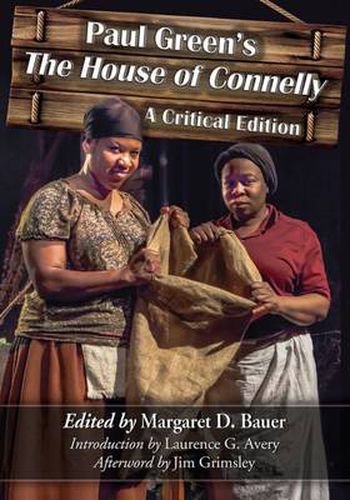Readings Newsletter
Become a Readings Member to make your shopping experience even easier.
Sign in or sign up for free!
You’re not far away from qualifying for FREE standard shipping within Australia
You’ve qualified for FREE standard shipping within Australia
The cart is loading…






This title is printed to order. This book may have been self-published. If so, we cannot guarantee the quality of the content. In the main most books will have gone through the editing process however some may not. We therefore suggest that you be aware of this before ordering this book. If in doubt check either the author or publisher’s details as we are unable to accept any returns unless they are faulty. Please contact us if you have any questions.
Margaret D. Bauer reintroduces one of Paul Green’s best plays, The House of Connelly, the first play performed (on Broadway, in 1931) by the renowned Group Theatre of New York. In so doing, Bauer also perhaps reintroduces the playwright himself, famous and well respected in his day, but largely forgotten today, except for his outdoor symphonic drama The Lost Colony, which continues to be performed every summer in Manteo, North Carolina. Green’s The House of Connelly is a more traditional drama, comparable to the writing of Tennessee Williams, and Bauer asserts that this play is as good as Williams’s plays and deals more directly and fully with racial issues of the early twentieth-century South than Williams did in his drama. Bauer’s new edition includes both endings to the play: the tragic ending that Green wrote originally and the revised ending he wrote upon the Group Theatre directors’ request. Bauer provides the writing, production, and publication history of the play; a scene-by-scene critical analysis, including an analysis of both endings; and a discussion of the 1934 film adaptation, Carolina. The play’s theme is change, Bauer concludes: with both endings, Green shows that the South had to change if the people were going to survive.
$9.00 standard shipping within Australia
FREE standard shipping within Australia for orders over $100.00
Express & International shipping calculated at checkout
This title is printed to order. This book may have been self-published. If so, we cannot guarantee the quality of the content. In the main most books will have gone through the editing process however some may not. We therefore suggest that you be aware of this before ordering this book. If in doubt check either the author or publisher’s details as we are unable to accept any returns unless they are faulty. Please contact us if you have any questions.
Margaret D. Bauer reintroduces one of Paul Green’s best plays, The House of Connelly, the first play performed (on Broadway, in 1931) by the renowned Group Theatre of New York. In so doing, Bauer also perhaps reintroduces the playwright himself, famous and well respected in his day, but largely forgotten today, except for his outdoor symphonic drama The Lost Colony, which continues to be performed every summer in Manteo, North Carolina. Green’s The House of Connelly is a more traditional drama, comparable to the writing of Tennessee Williams, and Bauer asserts that this play is as good as Williams’s plays and deals more directly and fully with racial issues of the early twentieth-century South than Williams did in his drama. Bauer’s new edition includes both endings to the play: the tragic ending that Green wrote originally and the revised ending he wrote upon the Group Theatre directors’ request. Bauer provides the writing, production, and publication history of the play; a scene-by-scene critical analysis, including an analysis of both endings; and a discussion of the 1934 film adaptation, Carolina. The play’s theme is change, Bauer concludes: with both endings, Green shows that the South had to change if the people were going to survive.